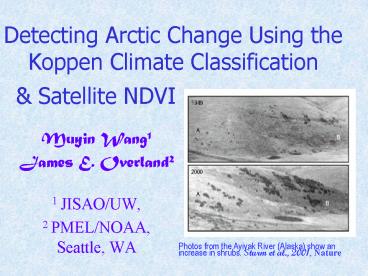Detecting Arctic Change Using the Koppen Climate Classification PowerPoint PPT Presentation
1 / 16
Title: Detecting Arctic Change Using the Koppen Climate Classification
1
Detecting Arctic Change Using the Koppen Climate
Classification
Satellite NDVI
- Muyin Wang1
- James E. Overland2
- 1 JISAO/UW,
- 2 PMEL/NOAA, Seattle, WA
Photos from the Ayiyak River (Alaska) show an
increase in shrubs. Sturm et al., 2001, Nature
2
The potential impact of vegetation changes to
feedbacks on the climate system is substantial
because of the large land area impacted and the
multiyear memory of the vegetation cover in the
Arctic region..
Atmospheric warming
3
The Koppen Classification
Data
NCEP/NCAR reanalysis 2.5x2.5 1948-2002
Kalnay, et al, 1996
CRU/UA TS2.0 0.5x0.5 1901-2000
Mitchell, et al, 2003
4
Vegetation Distribution based on Koppen
Classification
Tundra
NCEP
Frost
Boreal
1978
1998
Temperate
CRU
1950
1998
5
THE LOST TUNDRA AREA Max - Min
CRU 1950 1998
NCEP 1978 -1998
6
Calculated Vegetation Distribution Based on CRU
/NCEP
106 km2
Tundra
106 km2
Boreal
Temperate
106 km2
7
Anomalies of Tundra Boreal for sub-regions in
Arctic
10oW 120oE
106 km2
Scandinavia
Siberia
120oE 170oW
106 km2
170oW 80oW
106 km2
N.W. America
N.E. America
80oW 40oW
106 km2
8
Satellite Normalized Differences Vegetation Index
(NDVI) is calculated from the visible (VIS) and
near-infrared (NIR) light reflected by vegetation
in the AVHRR channels.
The value increases from 0.1 to 0.9 for
progressively increasing amounts of green
vegetation.
Global monthly NDVI data set is provided by NASA
on 1x1o resolution from July 1981 to September
2001.
9
Distribution of vegetation type based on Koppen
classification
The summer NDVI climatology
The lost tundra areas
The change in NDVI from 1980s to 90s
10
The Area of Tundra Group Based on CRU SAT And the
Averaged NASA NDVI for 50-90oN
Correlation -0.70
11
Change in Tundra Group Temperature Anomaly
Spring
Summer
12
CONCLUSIONS
- The Koppen classification based on SAT agrees
well with satellite NDVI. Both indicate a
significant decrease in the tundra area in the
past 20 years about 1 million km2 lost. - A similar decreasing trend was seen in the early
1900s, but with smooth slope. - Koppen classification gives good estimates on the
vegetation change over pan-Arctic region. It
agrees well with NDVI analysis.
13
Decadal Temperature Change (198998 - 198088)
Based on TOVS Path-P Data Set
14
WAVELET ANALYSIS OF TUNDRA GROUP TIME SERIES
15
Tundra Group and Temperature Series
Tundra Group 106 km2
Temperature oC
16
(No Transcript)

